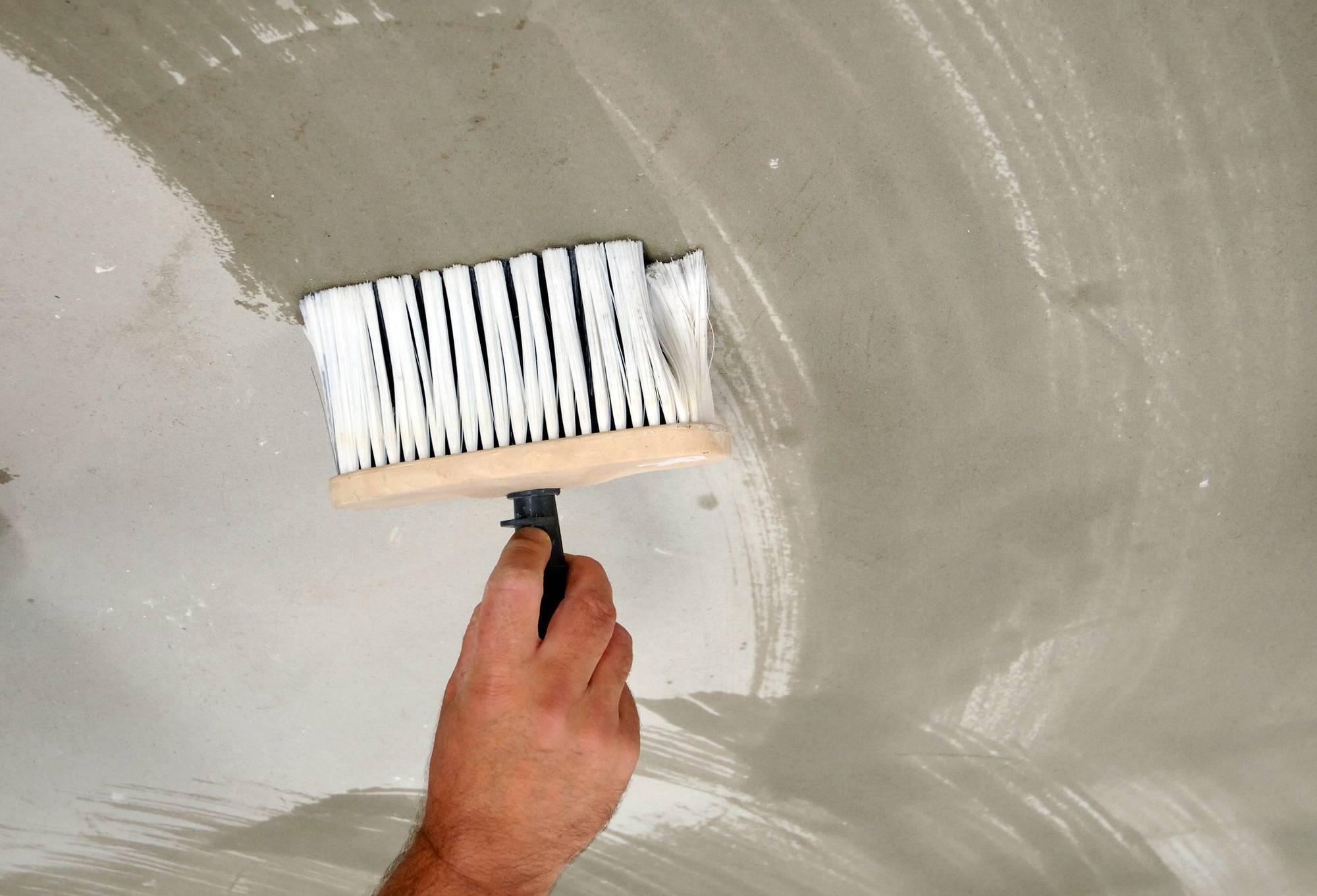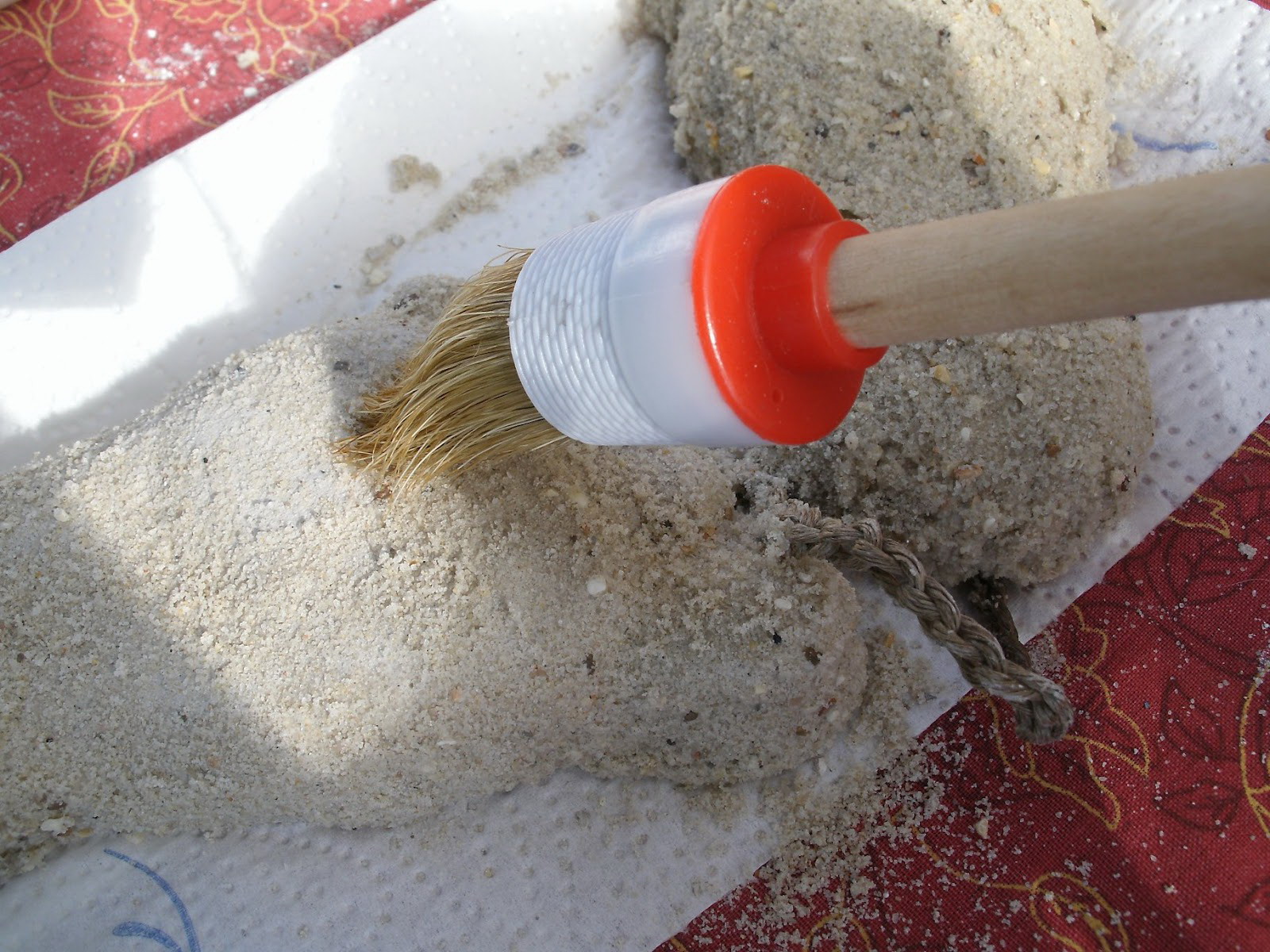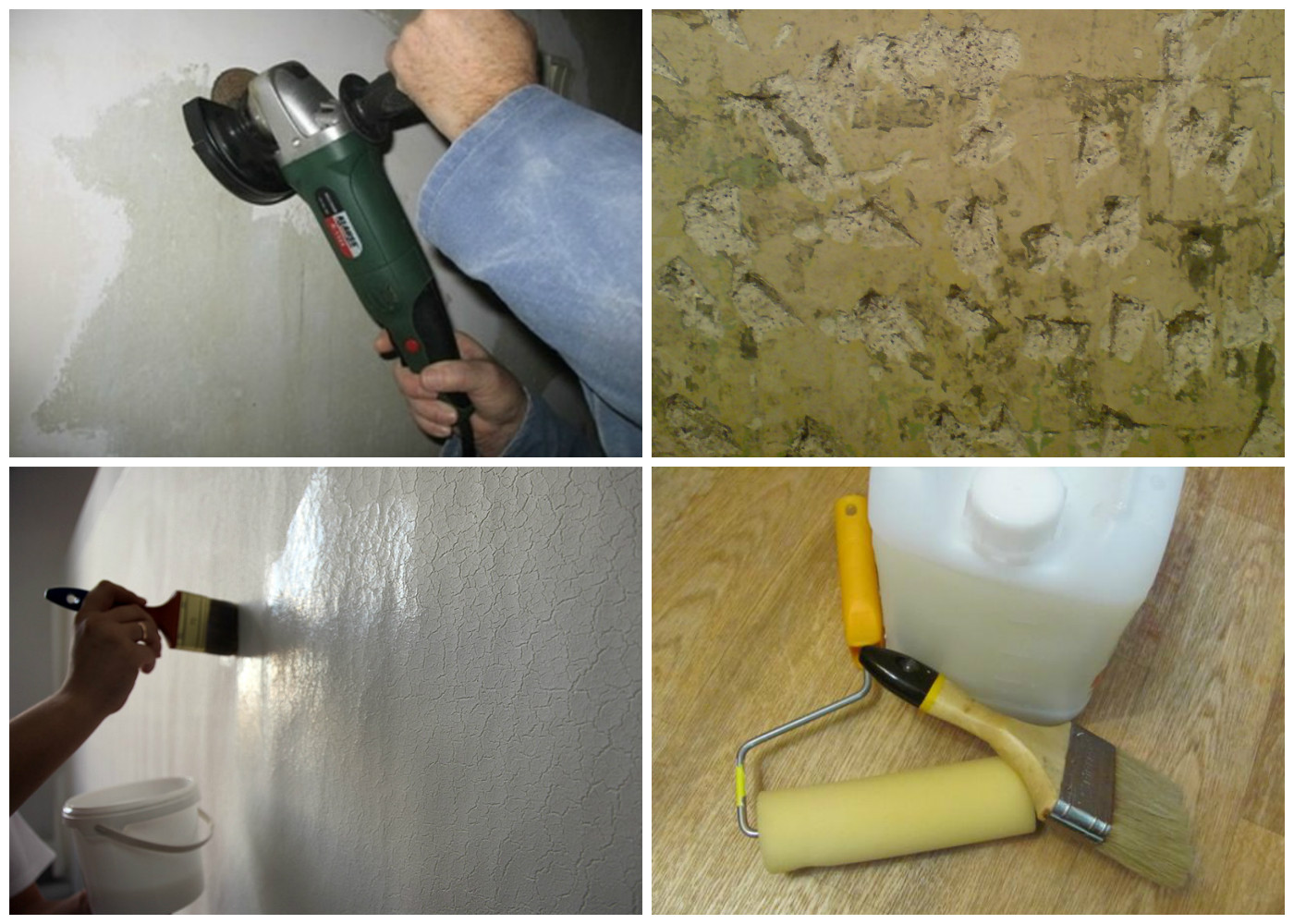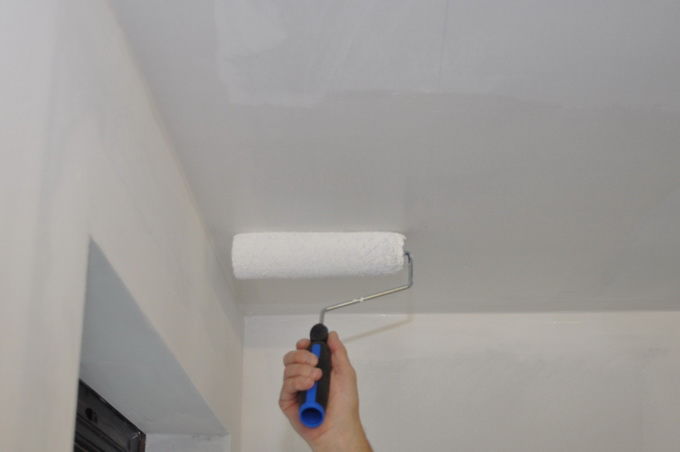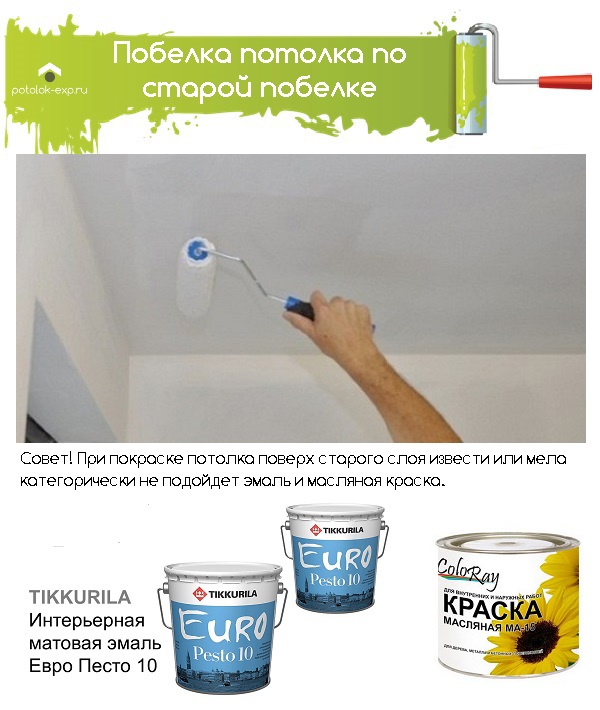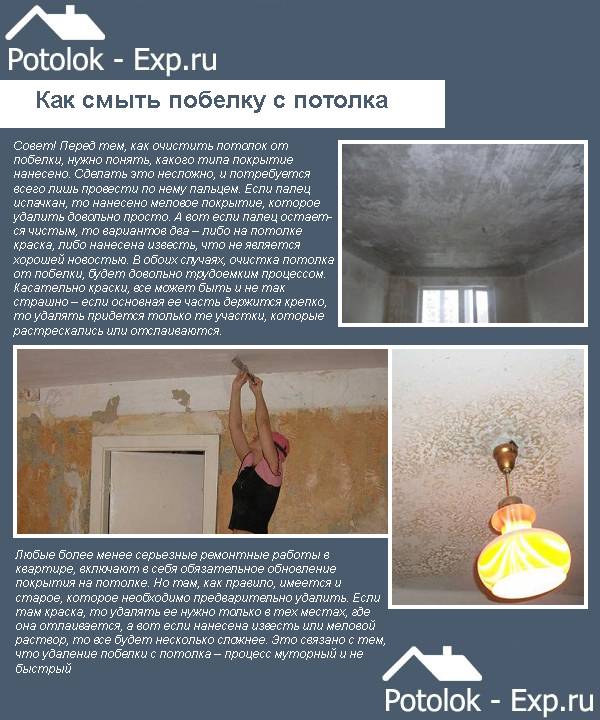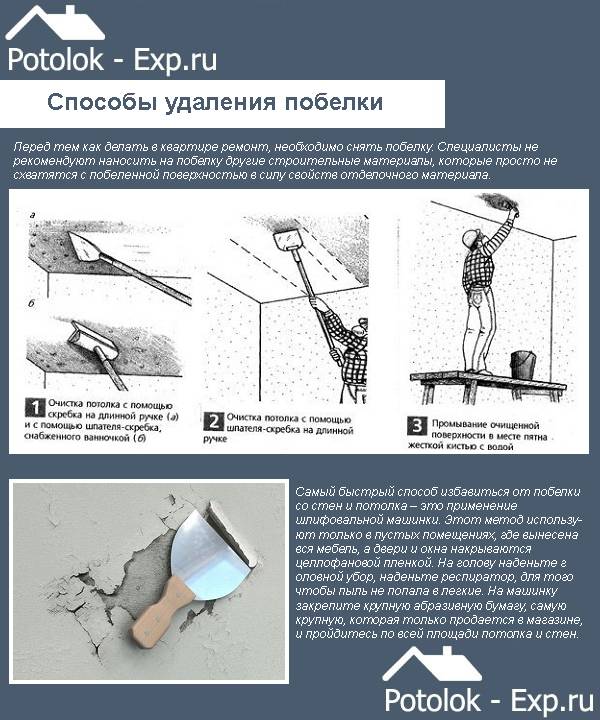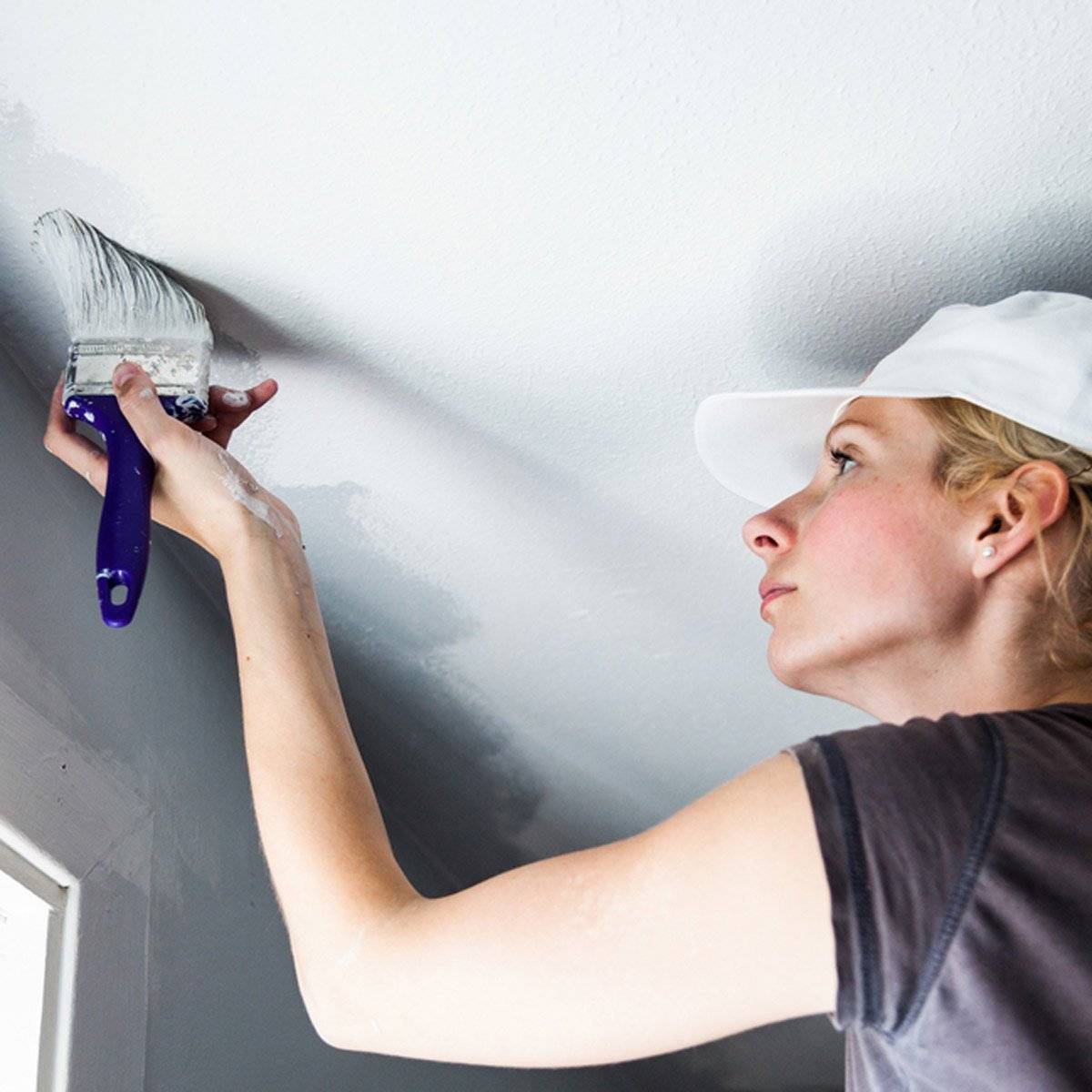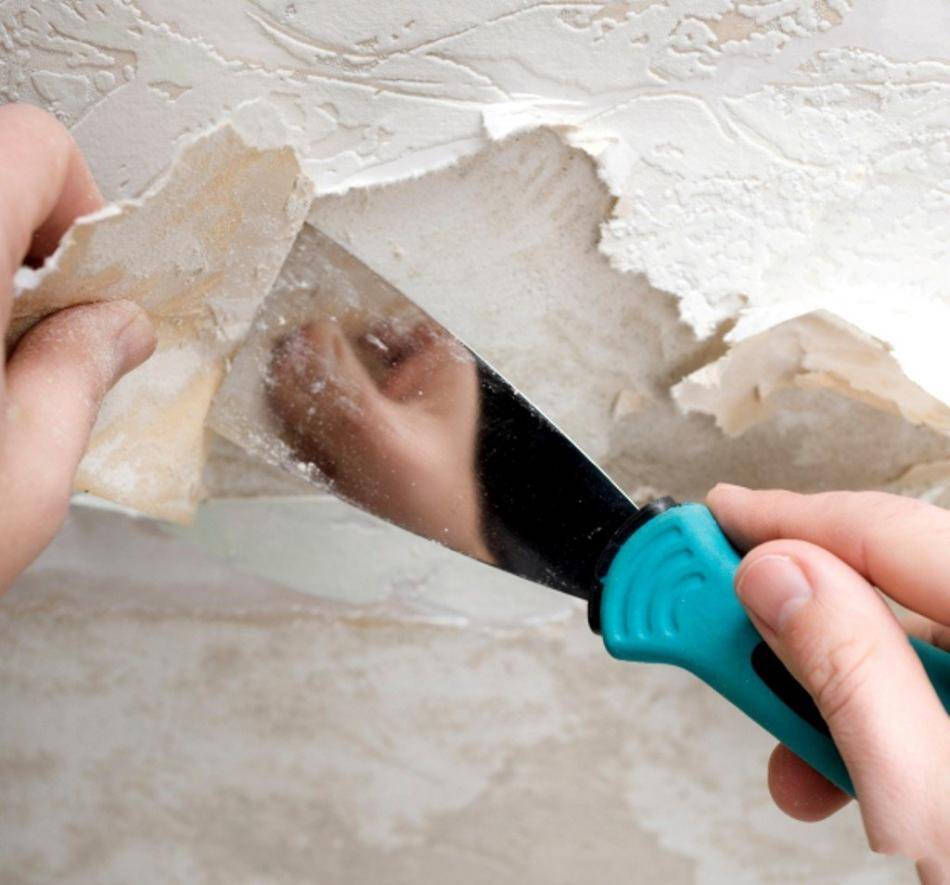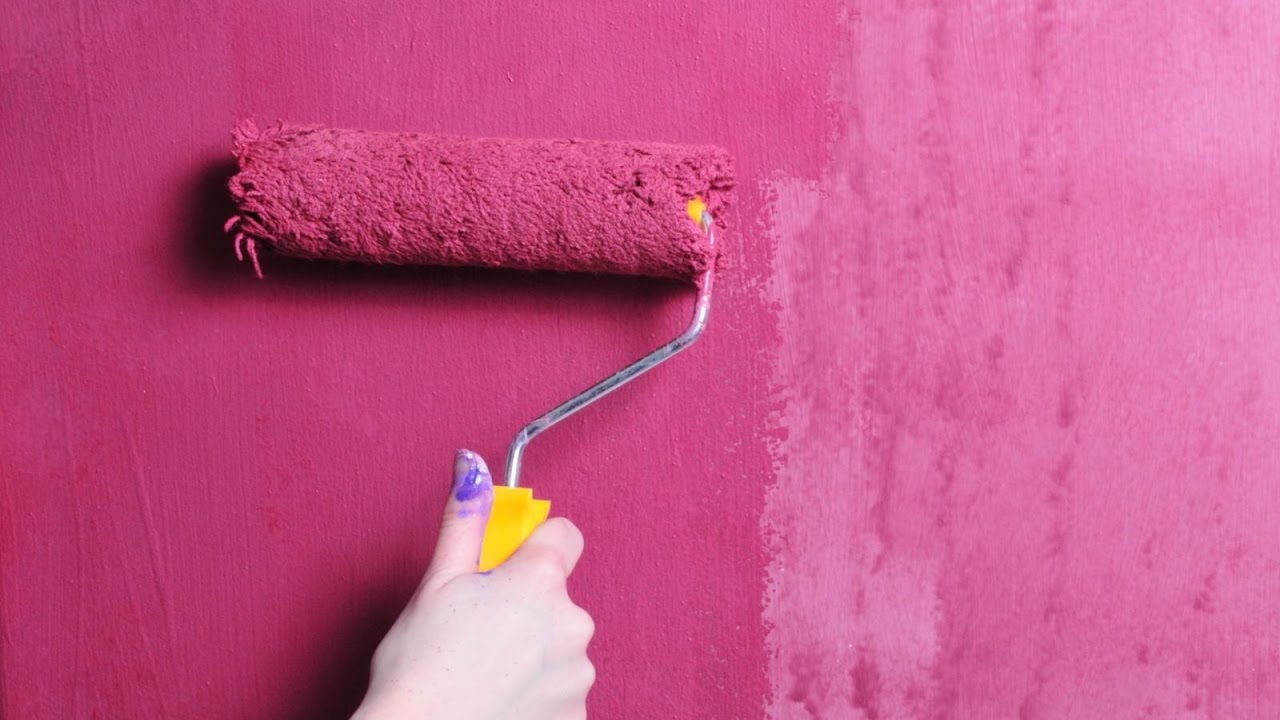How to wash off water-based paint?
There are several options for carrying out this cleaning. As already mentioned, the choice of one or another method depends on the coating from which the paint needs to be removed.
Mechanical method
When making repairs in an apartment or other room, the question very often arises, how to wash off the water-based paint from the ceiling? In an effective and efficient way, the masters note precisely the mechanical removal of the dye.
- Place a film on the floor so that paint residues do not damage the floor covering.
- Soak a soft-bristled roller in warm water and work over the area to be cleaned.
- Leave the ceiling damp for 10-15 minutes.
- Choose a spatula that is comfortable in width and remove any loose paint residues.
Important! When working with a trowel, make all movements in one direction only.
- Use a metal-bristled brush to scrub the areas where paint has not come off poorly.
Important! This method is not recommended for use on surfaces prone to scratching, such as linoleum. In this case, you should look for a more gentle method.
Soap solution - means for removing water emulsion
A proven method of removing paint at home is using a soapy solution. Since the paint is water-based, using water to remove traces from the coating will be as effective as using a mechanical method. The only thing to consider is that this method may take a little longer.
- Pour warm water into the prepared container and add soap or washing powder to it. Foam the product thoroughly.
- Use a roller or sponge to apply the liquid to the contaminated area.
- Leave the surface damp for 10-15 minutes to peel the paint away from the wall.
- Wash off any remaining paint with a damp cloth and occasionally rinse with water.
- Finally, wipe dry the cleaned area and make sure there are no soap residues.
Important! If soap stains have formed on the coating, the cleaning process will have to be repeated, only without soap
Wipe off dried water-based paint stains
If in the process of covering the walls or ceiling it was not possible to avoid the appearance of paint marks on the linoleum, or you did not notice and did not clean the flooring in time, take note of the following method.
- To soften the dried stain, apply a small amount of water to the paint mark.
- If the contamination is large enough, dampen a clean cloth and cover the stain.
- Leave it on for a while to let the coloring matter peel off the floor.
- Clean the remaining dirt with a brush or a regular cloth.
Important! To clean delicate surfaces such as linoleum or parquet, do not use products that contain abrasive substances or brushes with stiff bristles to avoid damaging the flooring.
Use of solvents
The easiest and fastest way to wipe off old traces from a water-based emulsion or several layers of such a coating can be done with solvents. In this case:
- Formic acid.
- Isopropyl alcohol.
- Chloromethane.
These solvents are safe for the environment and degrade quickly, but are very expensive when used over large contaminated areas. You can use other solvents that will do the job well.
Important! Before use, read the instructions and the composition of the selected product. Often toxic substances are added to the paint remover that can harm your health.
Flushing and related steps
Before starting work, you need to properly moisten the ceiling surface with a soft roller, regularly dipped in a container of water. Then the coating is left to soak for 15-20 minutes. It is best not to process the entire ceiling at once, because by the time the work reaches the opposite corner, everything will dry up there again.
With a spatula, carefully, trying not to leave scratches, remove the soaked paint from the ceiling. In order for it to lag better, it is recommended to easily tap it with a small hammer. Then the spatula will simply remove it in layers. Where difficulties are encountered, you can use a wire brush or moisten the coating again.
There are little flushing secrets from those who have repeatedly done this:
- add a bottle of iodine to a bucket of water, this will facilitate the process;
- wash off not with plain water, but with soapy water, this speeds up the work;
- you can apply the soapy solution with a brush, and then remove it with plain water;
- for paints on a different basis there are certain chemical additives (for acrylic, for example, salicylic acid or vodka).
There are also several types of construction washes, which are applied in a layer to the ceiling, left for 15 minutes, and then easily and simply removed from the ceiling with a spatula.
But it should be remembered that this method of flushing leads to contact of the respiratory system with harmful chemicals, and you must either work in a respirator or use them with the greatest care. Rinse off water-based paint is the easiest and most affordable way, however, new technologies have led to the creation of waterproof materials on different bases that simple water, or even a detergent solution, cannot be handled.
Choice of color and type of coloring material
Water-based paints are composed of water, various polymers and color pigments. The ceiling can be painted with several types of coloring composition, the properties of which depend on the binder included in it:
Acrylic paints. Contains acrylic resins and latex filler. They form on the surface a fast-drying thinnest film, resistant to fading, actively resisting water and masking small cracks 1 mm wide.
Silicone paints. Water-dispersion solution based on silicone resin. Paints cracks 2 mm wide, vapor-permeable, waterproof, antibacterial.
Silicate paints. An aqueous solution of potash glass and colored fillers. The mixture is resistant to temperature extremes, biological effects and ultraviolet effects. It is a hydrophobic, vapor-permeable and fireproof paint. Disadvantage - not suitable for painting the ceiling in rooms with high humidity.
Mineral paints. Made on the basis of slaked lime or cementitious substances. Apply to smooth surfaces.
All types of water-dispersion paint emulsions are easily applied to the surface, creating a durable elastic film after drying. They are able to plug microcracks, dry quickly, have no odor and, if desired, can be tinted in any shade.
Note: Read about how to paint your bathroom ceiling.
Remove mechanically and thermally
For the first option, you will need a drill and a grinding attachment, and for the second, a building hair dryer. The drill attachment is a metal bristle brush. With its help, water-resistant water-based emulsion or thick layers that could not be washed off are removed. The disadvantage of this method is the large amount of dust emitted during work.

Removal of water emulsion with a building hair dryer is a thermal method. Heating with a hairdryer, the paint is cleaned off with a spatula. The heated paint cracks and is easily peeled off. Often, after such treatment, small areas with a thin layer remain; they are cleaned off with a brush or drill with a nozzle.
After that, the surface must be washed or dust removed with a vacuum cleaner.The disadvantage of this method is the price of a building hair dryer.

A few more ways to delete
You can also wash off the water emulsion using additives:
- the paint can be easily removed if iodine is added to the water (200 ml of iodine per bucket of water);
- soap solution - coat the surface with soapy foam and rinse with a rag;
- if the water emulsion has an acrylic base, vodka or salicylic acid can be added to the soap solution;
- paint with an admixture of latex is removed by adding dichloroethane or chloroform to the water.
The easiest way is to hide it behind panels, install a suspended or stretch ceiling. You can get rid of old water-based paint with a paint remover. The jelly-like mass is applied to the surface, the period specified in the instructions is maintained and wiped with a solvent. Then it is scraped off with a spatula. With this method, dust is completely absent, but it takes a long time.

As an alternative to the shredder, you can use special washes. They contain a solvent based on dimethyl chloride, formic acid and other organic substances. They decompose rather quickly, so they are not harmful to health or the environment.
Quite an economical way, 1 liter of wash is enough for 5 square meters of surface. Washes can be equally effective on old coatings of several layers, as well as on waterproof water-based paints.
Watch the video: An easy way to remove old water-based paint
Features of the process of removing water-based paint
First you need to wear respirators and goggles intended for construction. Then we use small spatulas and stepladders. Just by that time, the old layer of water-based paint will already completely swell and swell.
But nevertheless, there may be places where the old layer is scraped with great difficulty, it is necessary to knock a little with a hammer on this place, in which case it will immediately succumb. Or you can once again moisten this layer of old water-based paint with water gradually and give it time to swell.
And finally, after removing the old layer of water-based paint, it is necessary to sand the ceiling, this helps to remove the smallest paint residues.
But there are other ways to remove water-based paints from the ceiling with bare hands, which do not require special skills to work, as well as tools and / or materials for successful work.
Among such ways and methods of work, the following examples can be distinguished, which are not only the most popular, but also incredibly effective.
With paste
To do this, it is necessary to make starch-based pastes, or you can simply purchase glue, then you need to process the ceiling with a roller moistened with this liquid. Immediately after this, you must attach a newspaper.
After that, you need to wait a little, you need to wait until the ceiling is completely dry. Yes, yes it is with the old layer of water-based paint. And at the end, it is necessary to speed up the removal of this layer with light movements, using a spatula.
With the help of the destroyers
If you prefer to use this method, you need to apply this mixture to the ceiling, and after a while you will need to scrape off the paint.
It is best to apply this method not to the entire ceiling as a whole, but to distribute it into parts.
With iodine
Yes, iodine can actually penetrate the layers of old water-based paint. The method of application is in the instructions that come with iodine.
Thus, the tips presented in this article of our resource will help you not only to properly organize the work on the removal of water-based paints, but also to remain satisfied with the result of the work done.
An attentive attitude not only to the procedure itself, but also to all its stages is the key to the successful completion of the process you have begun.
The ways
There are several ways that help to effectively cope with this task.
1st way
For this we need an additional tool - this is a metal brush.
There is, in principle, nothing complicated either.
Step 1. First of all, in this case, the surface painted with waterproof paint is treated with this brush - the numerous scratches formed on the paint are precisely the damage through which moisture can now penetrate.
 Metal brush
Metal brush
Step 2. In the second step, we do everything the same as we did when we removed the usual water-based paint - we wet the surface with a roller or sponge. This is done in two stages with a break of 15-20 minutes. This is necessary in order for the paint to come off for sure. After moistened, it is necessary to create a hole in the room - we open windows and doors - this will further contribute to the paint escape from the base
Step 3. Well, at this stage, it remains to pick up a spatula and scrape off the peeling paint.
2nd Method
This is another invention that allows you to wash off water-based paint from the surface. To do this, you will need the most ordinary wallpaper glue, you can use any one here, there is no point in buying expensive, we take the most ordinary and cheapest one.
We also need sheets of paper.
 Step 1. The prepared glue solution is applied to the surface and paper is glued to it
Step 1. The prepared glue solution is applied to the surface and paper is glued to it
Step 2. As the glue dries in the second step, we begin to peel off the glued paper.
From the corner, using a spatula, we pry the paper, and we begin to tear it off from the ceiling.
Together with the paper, paint will begin to come off, so that the paper does not break anywhere, you can use a spatula.
3rd Method
How else can you remove water-based paint?
There is another way that involves mechanical action. To do this, we need a drill or screwdriver with a special grinding type attachment.
The disadvantage of this method is that it is quite dusty. Since it involves sanding the ceiling, the crushed paint and concrete are scattered with a grinding wheel over all areas. Here you will also need additional eye protection - special glasses.
Here are the main ways that you can wash off the water-based paint from the surface of the walls or ceiling. Which one to use is at your discretion, proceed from the available tools.
The main cycle of work
Next, work is waiting for you to remove the old ceiling covering. Since you will have to work with your arms raised high, you will quickly get tired - remember to take breaks. The longer the work lasts, the longer these breaks should be. If you do not follow this advice, then the next day you simply will not be able to raise your hands - it will hurt a lot.
The most common ceiling problem is old whitewash. Natural limestone, classic. The thing is that before the new whitewash, its old layer was not removed, and the older the apartment, the thicker and more solid the layer of lime can be, and the longer it will take to remove it.
But the process is simple, and, in principle, there should be no difficulties during cleaning the ceiling - you just need to thoroughly wet the area and pry off the wet whitewash with a sharp thin spatula. You can moisten everything with a sponge or a spray bottle, it doesn't matter, and you can do it the way you like.
Methods and methods for removing water emulsion
How to quickly clean the ceiling from different types of water-based paint? There are two universal methods for removing water-based paint, which are used with varying success if you need to remove water-based paint from the ceiling.
-
-
The first way is to soak the paint with warm water using a regular paint roller. In this case, there is no need to soak individual pieces, the entire ceiling can be traversed in one go with a roller with a telescopic handle.In the event that the paint is water-repellent, it will take much longer to soak it, several times, until it absorbs enough moisture.
When the paint swells, it means that it is already ready for processing - now all that remains is to remove it with a spatula. In order not to damage the plaster or the surface of the slab with the sharp edges of the trowel, it is best to hold it at the most acute angle relative to the surface of the ceiling. The most stable areas can be soaked a few more times.
-
The first way is to soak the paint with warm water using a regular paint roller. In this case, there is no need to soak individual pieces, the entire ceiling can be traversed in one go with a roller with a telescopic handle.In the event that the paint is water-repellent, it will take much longer to soak it, several times, until it absorbs enough moisture.

-
The second way is to glue the newspapers. He will need a stepladder and patience. The paint must be coated with an adhesive that is suitable primarily for water-based paint. It is necessary to glue newspapers on it and let it all dry well.
After drying, the paint soaked with glue should lag along with the newspapers. Those areas on which the glue did not hit, or they simply did not soak, will need to be re-sealed with newspapers. And rip it off.
Acrylic water-based paint can be easily removed with a simple mechanical action. A knife or spatula is great for this. As a last resort, you can use a chisel.
Acrylic paint is also well washed off with water, with proper persistence, hot soapy water will quickly remove it from the ceiling without leaving a residue, but it must be rubbed well with a washcloth or something similar.
Almost all types of water-based paints can be removed from surfaces using other methods. One of the good and effective methods is the thermal method. The paint is heated with an industrial hair dryer or blowtorch, making it soft and pliable. Thus, it can be easily removed with a spatula. But for this method, it is advisable to ventilate the room well and is certainly not suitable for apartments in which there are people.
Another method by which you can remove almost any paint, regardless of its base, is stripping. It is carried out with a hand grinder, or a special attachment for a grinder or drill. The drill is more convenient.

With the help of a brush, you can remove absolutely all the old paint, without leaving any residue, but this method is very dusty and will require additional protection. He needs at least a respirator to protect the respiratory tract from fine and very corrosive dust. It is also necessary to cover all objects and furniture in the room with dense polyethylene.
It is also necessary to tightly curtain all doorways and windows. Depending on the area of cleaning and the specifics of the paint, this method can be much more economical in time and much more efficient than soaking or using glue, since all the necessary consumables require only a brush with metal bristles.
My ceiling
Traces of gas combustion products, evaporation of liquid during cooking, flies and mosquitoes often remain on the ceiling in the kitchen. To keep it from getting too dirty, it should be cleaned regularly. If there is no stepladder, then you can use a special mop with a long handle and a swivel mechanism.
First, the most contaminated surfaces are treated with soda or saline solution. Then the soft cloth should be rinsed thoroughly in clean water. Having wrung out the excess water from the rag, wipe the entire ceiling, if necessary, the procedure can be repeated by replacing the dirty water with clean water.
If you use a cloth that is too damp, then ugly stains may remain on the surface (especially if it is colored). After wet cleaning, the base is thoroughly wiped with a soft dry cloth.
You can try to remove mold marks with a special anti-fungal spray. If this does not help, then copper sulfate is used, but after that the ceiling will have to be repainted.
Safe work
It is difficult to clean the ceiling, this procedure requires special skill and takes a lot of time.
 When cleaning the ceiling, use a stepladder.
When cleaning the ceiling, use a stepladder.
For easy access to high ceilings, use a stable ladder. It is desirable that it has a wide area for placing a container with a soapy liquid.
Gloves are used to protect the skin of the hands from detergents. Protective goggles should be worn to prevent the cleaning solution and dust particles from entering the eyes during operation.
It is better not to take hard mops so as not to damage the ceiling, it is better to take a soft cloth.
When washing, they capture small surfaces, you do not need to reach far. It is better to rearrange the ladder once again so as not to fall off it. It is desirable that there is an assistant below who, if necessary, will provide the necessary items and insure.
Effective washing
To clean the ceiling effectively, you must use a soft, lint-free, non-fading cloth. Instead of a cloth, you can use a foam sponge.
 The surface of the ceiling is washed with a soft cloth.
The surface of the ceiling is washed with a soft cloth.
Wipe the ceiling with soft hand movements; no pressure is required on it.
For surfaces painted with a water-based solution, do not use cleaning agents that contain an abrasive, acid or other reactive component.
You cannot use toxic solutions, the surface will be damaged, it will have to be updated, and the room will need to be ventilated for a long time from the pungent odor.
How to wash properly
After the end of the process of cleaning from dust with the dry method and the beginning of wet cleaning, it is important to properly prepare the detergent composition. Do not add bleaching ingredients to the water, as they will result in lighter areas on the ceiling.
There is also a risk of removing the dye from the surface. As a result, it will have to be painted again.
All movements are recommended to be performed as smoothly and softly as possible. Do not rub the coating very vigorously with a rag or sponge. To get rid of streaks and remove the most pronounced impurities, baking soda is injected into the water. If the use of a soap solution does not bring the desired results, use baking soda.
It is recommended to take 3-4 large spoons of the substance in a bucket of water. Then it is worth rinsing the most contaminated areas. After a quarter of an hour, it is recommended to wash the treated surface with water. Finally, it should be blotted with a clean and dry cloth. In a bathroom or lavatory, mold often appears on the ceiling. In such a situation, it is recommended to treat problem areas with antifungal agents before washing. They are sold as aerosols.

After that, it is worth treating the surfaces with soapy water. If it was not possible to remove traces of mold, it is recommended to use copper sulfate. After the surface has dried, it is recommended to treat it with an antiseptic composition. This will help prevent mold from developing later. It should be borne in mind that after applying radical methods, it is recommended to paint the ceiling surface. It is permissible to do this with water-based paint. It is applied in one layer.
Ceiling cleaning is considered a fairly straightforward process. However, it is not always possible to achieve good results. If the dye does not contain acrylic or silicone, it will not be able to withstand the use of aggressive substances or intense mechanical stress. In such a situation, it is much easier to apply a fresh coat of dye.
How to remove acrylic paint from the ceiling

There are enough ways to remove paint:
Gel intended for washing stretch ceilings. It is, of course, expensive, but for the sake of saving the ceiling covering, you can spend money. If you don't have the option, take advantage of the more economical options.
Dishwashing liquid or soapy water. Moisten a sponge or rag with any soft cloth with one of the means, start washing the paint. You will have to rub the tracks several times. Remember! You can not wipe off acrylic paint in a circular motion, only forward movement and backward movement.
Hydrogen peroxide.Dampen a flannel rag with 3% hydrogen peroxide solution and scrub the stains. Then wipe dry.
The above methods of how to clean the ceiling from paint may be useless. In this case, cash costs cannot be avoided. You will have to seek help from specialists who will remove the damaged part of the ceiling and replace it with a new one. Or use the latest acrylic paint remover.
Not only acrylic paint, but also water-based and oil paint can get on the ceiling.
More often, water-based paint gets on the stretch ceiling when, after its installation, the walls are painted. There is nothing better than washing water-based paint from the ceiling with plain water at a temperature of 60-70 degrees. Long-standing heel of paint must be walked several times with the rollers dipped in water. The paint should soak for about fifteen minutes. Then we have a mechanical effect on the surface. Use a rubber or plastic spatula to scrape off the paint.
Equipment and necessary equipment
The removal process is best done in a completely empty room, but sometimes it is not possible for this, and then all objects are removed from the furniture before the procedure, the surfaces are covered with a layer of fabric, and on top with plastic wrap. This is an essential contamination protection measure. It is recommended to spread the film in an empty room, so that later you will not bother with laborious cleaning and not think about how to remove untidy marks from the floor.
Anyone who will remove the ceiling layer must be appropriately equipped: be sure to wear protective clothing, with glasses, gloves and a head cover. If you have a respirator, you can use it to avoid getting paint and dust particles in your lungs.
It is advisable that households, outsiders and idle advisers do not hang out in the room. In addition to emotional disturbances, they will also trample the paint to be removed on the floor. In order to reach the ceiling, you will need a building ladder or an old stable table if not available.
To carry out the work directly, you will need very simple tools:
- rags, preferably natural, absorbent moisture;
- container with water (basin or bucket, for ease of movement);
- soft roller for wetting the surface;
- sandpaper of different grain sizes;
- metal spatula;
- scraper with a comfortable handle;
- metal-toothed brush:
- building solvent;
- acetone.

You can remove water-based paint in different ways: rinse with water, remove by heat treatment, using solvents. It all depends on what surface and how many times it was applied and how long it served as a decorative agent in the room. The paint can be simply peeled off with a brush or sander. How to remove, you need to decide on the spot, based on the allotted time and cash.
Cleaning the ceiling from oil paint
How to remove oil paint from the ceiling, as it is the hardest to remove? For this, three methods are used: thermal, chemical and mechanical.
The traditional method of disposal is chemical. A chemical solution is preliminarily prepared, which is applied with a paint roller to the surface of the ceiling.
The floor softens the paint and can be scraped off with a metal brush. This method is the fastest. When using paint in several layers, you will need to carry out this procedure several times.
A mixture of potassium carbonate and lime can be used as a mixture for chemical treatment. To do this, you need to mix 1.2 kg of quicklime and 400 g of potassium carbonate in water, and then soak the mixture in water.
Advice. The choice of paint removal method is necessary depending on its type. Water-resistant and oil-resistant require careful removal, while water-based emulsion can be removed easily.
Method two: newspapers and glue
When the first method did not quite help and the paint is still there, it is better to resort to newspapers. We can say that this method takes less effort, but it takes more time. You will need to weld the paste or prepare wallpaper glue, a spatula, a stepladder, a wide brush or a sponge. How to remove water-based paint from the ceiling with newspapers:
- grease a small area of the ceiling with adhesive;
- glue newspapers on top;
- leave for a while to dry the newspapers;
- pry the paper with a spatula along with the paint and gently tear off;
- remove the remaining paint with a stiff brush.

We recommend:
How to get rid of foot odor - odor remedy
The only disadvantage of the method is the need to wait for the glue to dry, and it can take from a couple of hours to several days. It all depends on the temperature in the room: in summer, the process goes much faster than in the cold season.
How to remove fresh dirt on different types of fabrics
Work clothes look dirty after repairs. Water-based paint leaves streaks and stains. It is necessary to be able to remove contamination using proven methods.
Denim
It is more difficult to remove bright streaks from heavy fabric. You can try rubbing the stains with a solvent such as white spirit or acetone. Then the item is put into the washing machine, rinsing thoroughly at the end.
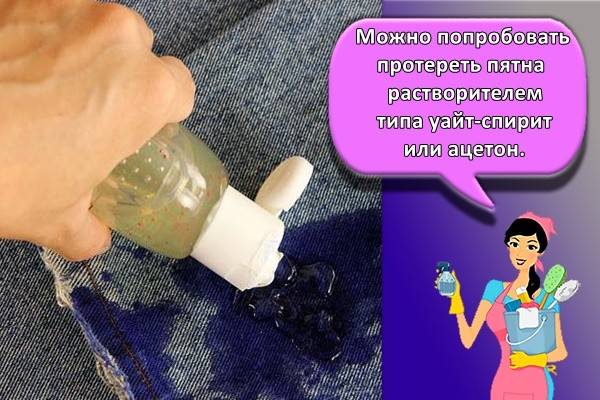
Natural
Satin, chintz robes, cotton shirts are cleaned with gasoline, placing paper under the material. Helps get rid of dirt and solvents. In the end, be sure to wash things in soapy water.
Synthetics
It is easy to ruin a piece of polyester or other synthetic material if you use solvents to remove stains. It is better to use vegetable oil here. Moisten a cotton pad with oil and wipe off the dirt. Put paper under the fabric. It will take a long time to wipe off the dirt. When the goal is reached, the thing is washed in soapy water.
Types of water-based paints and features of their removal
Water-based paints are divided into several categories, depending on the polymer they are based on.
Today, four of these types of paints are most common:
- acrylic;
- silicone;
- silicate;
- mineral.

Acrylic paints - the most expensive and the most resistant to the influence of various destructive factors. They are based on acrylic resins, which, after drying, harden to such an extent that they can be washed with water and detergents.
It is not easy to erase acrylic paints, but one of the reliable methods is solvents and alcohol.
Silicone paints are also resin based, but silicone paints. These paints are in no way inferior to acrylic in performance, and, in addition, they have a moisture resistant effect and vapor resistance. How to wash off the water-based paint from the ceiling? Such paint can only be removed using special washes.
Silicate paint is, in fact, liquid glass mixed with water and a colored pigment. Such paints are durable and fit perfectly on any surface. True, they are not suitable for too damp rooms, but it is quite easy to remove them - just add water and scrub well.
The composition of mineral water-based paints includes lime or cement. These paints are designed for use on brick or concrete surfaces, mainly outdoors.
Despite their relatively short service life, they initially have good resistance to atmospheric influences. To remove this kind of paint, a special remover is the best option.

Method one: soaking paint with water
Old water-based paint can usually be removed well with hot water. The layer must be soaked and then removed with a spatula or stiff metal brush. How to remove water-based paint from the ceiling:
- moisten the ceiling abundantly with warm water using a roller (this should be carried out several times, as the water will drain);
- wait 5-10 minutes for the substance to dissolve;
- start to remove the paint with a spatula or a stiff metal brush;
- wet the ceiling again and continue to work in stages.
 You need to apply water with a roller to small areas, otherwise they will dry quickly. You can use a spray bottle to make the process take less time. Removing the water-based paint does not take long. Be sure to take into account: if there were many layers on the ceiling (this usually happens in old apartments), then you will need to repeat the cleaning 2-3 times.
You need to apply water with a roller to small areas, otherwise they will dry quickly. You can use a spray bottle to make the process take less time. Removing the water-based paint does not take long. Be sure to take into account: if there were many layers on the ceiling (this usually happens in old apartments), then you will need to repeat the cleaning 2-3 times.
Some masters advise replacing the water with soapy water and cleaning it using a sponge. Use it to wash off the dye by wetting the ceiling abundantly. The technology has many disadvantages, for example, it takes a lot of time and effort to wipe off the substance. If there are several layers of paint on it, it is better to give preference to other methods.
How to get started?
Before proceeding with the direct removal of paint from the surface, it is necessary to determine the type of coating treated with the dye. The method of how to wash off the water-based paint will depend on this. You should also prepare in advance all the necessary equipment for this work.
- Place plastic wrap or newspapers on the flooring so that all debris from the wall does not contaminate the linoleum or parquet flooring.
- Prepare a basin or bucket of clean water and rags.
- You will need a spatula to scrape off any remaining paint.
- Find a soft-bristled roller to wet the walls or ceiling with water.
- A metal bristle brush will help you scratch the finish so that water gets inside the paint.
- Prepare sandpaper.
- A thinner or acetone will help achieve the best result.
- Put on work clothes.
- Prepare a ladder or stepladder to increase access to surface treatment.



